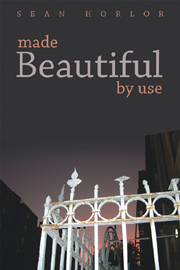Sean Horlor, Made Beautiful by Use
reviewed by Joanna M. Weston

Made Beautiful by Use Publisher: Signature Editions ISBN: 978-1-897109-13-7 |
Horlor, according to the backcover blurb, asks if “Is it possible for anyone to be conscious, compassionate, and ethical in a twenty-first century world?” In the first section, ‘Empty container’, Horlor writes poems of praise: praise of beauty, solitude, what is found again, verse, listening, and letting go. It is in the last two that the question of consciousness is most clearly addressed:
|
... Trampling, plush with intent, it’s my voice pounding at the door. ... What did you just hear unfurling in your ear’s delicate rosette? ... A whistle. A knock. The unanswered door. ... There are moments the human body amplifies absolutely. — ‘In Praise of Listening’, p.18
|
There are consonants, sibilants, and understated alliteration, as with the m’s in the last couplet, to bring attention to everyday sounds. It is a poem to be read aloud to bring into awareness the sense of hearing.
With ‘In Praise of Letting Go’, Horlor takes an empty container and suggests filling it with ‘an angle of volcanic rock / where decades of tree growth wash up as they are: roots intact ...
Let us choose carefully then, the general view
and what it means to us, our own
collusive scenery: a homestead,
...
until night leafs into place above
a field with two floodlights and farther
along the horizon, the red feather
of a radio antenna flashing against grey cloud. (p.19)
He moves from the solidity of earth, the antiquity of natural surroundings, to the empheral flashing light of the antenna, bringing awareness of the transitory nature of radio communication.
There is warmth and beauty in images such as ‘The morning, the sky / came down to lie against the earth’ (p.33). Here compassion and love combine with the vision of a cloud resting in a valley on a cold morning, while the couplet that follows challenges and contradicts, ‘Yesterday, a small bird flew in / to the window and broke its neck’ (p.33). The line break gives pause and an expectation of beauty, instead the reader is jolted with the death of the bird. Faith in goodness becomes rather a question than an expectation. In ‘Love, or What should you believe in?’ Horlor says
This word would be easier if
I could just say heart
before moving on to the short journey fingers make
between the buttons of a clean shirt —
then fold the heart over until all
that remains is its semblance across this page.
A blueprint. An ink blot. Something
to interpret under another’s care:
There is no wrong answer.
...
What faith. What terror.
If love was only to touch the physical heart it would be easy. But because it has to be interpreted as is a Rorschach test, all answers are correct, and it is terrifying to realize that whatever one says in a given context is right in a world where there are no absolutes and innumerable shades of grey.
In ‘Talking to Other Canadians About Canada’ (p.50), Horlor says that ‘Sometimes the most important tasks of love / are done by everyone.’ He acknowledges that love has as many faces and answers as the actions that reveal it.
The divisions of the book are brief and definite: ‘The Empty Container’ which deals with beauty etc.; ‘St. Brendan the Navigator’; ‘The Seven Heavenly Virtues’; ‘St. George the Dragon Slayer’; and ‘Hagiographies’. It is the only the satirical section in which George W. Bush is cast as St. George that appears to stray in tone from the rest of the book.
His language, however, flows like silk over the hands: it is smooth, evocative, and richly patterned. There is need to pull a thread, pick a word, and follow the pattern to its conclusion, to verify the design of his work. The connections and insights are contemporary and of spiritual depth. Any later book will surely be worthy of note.
first published in The Danforth Review
Copyright © 2009 by Joanna M. Weston

